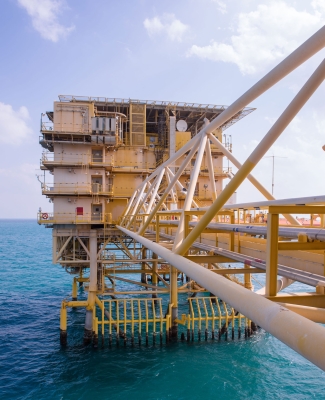
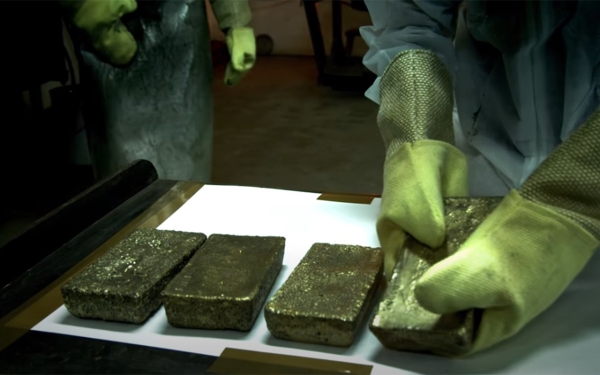
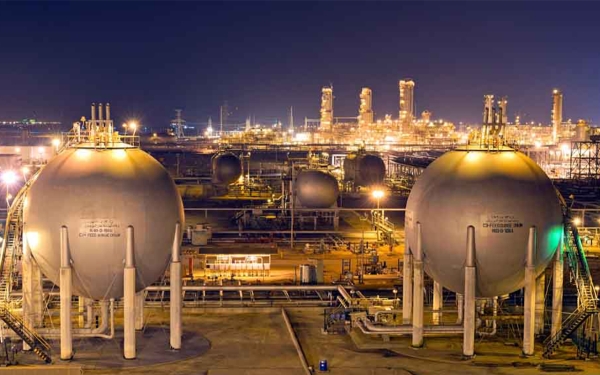
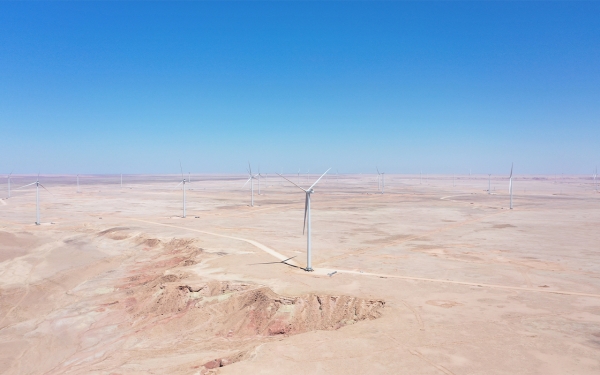
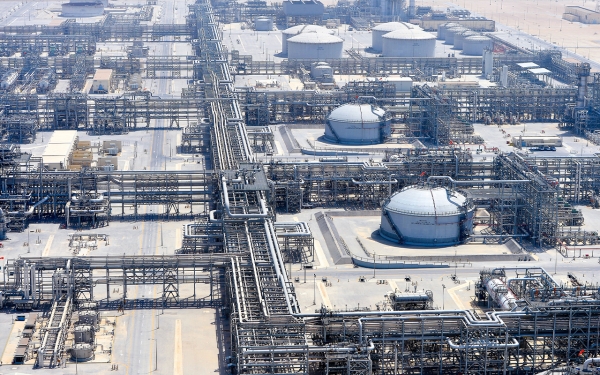
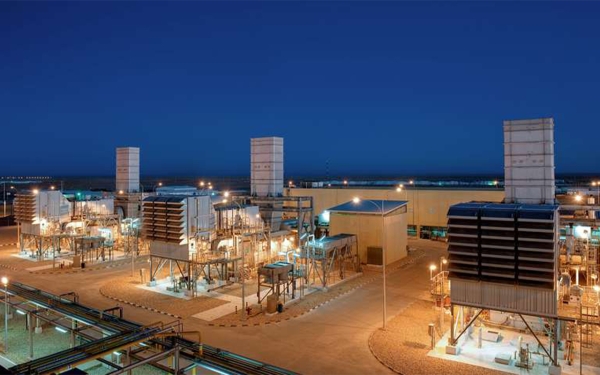
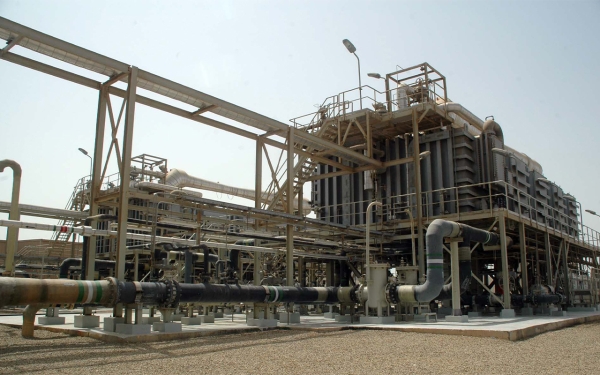
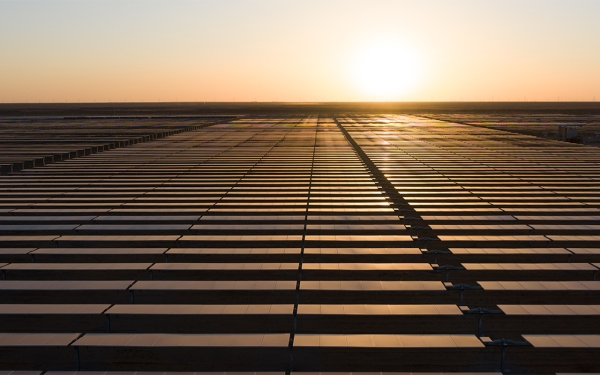
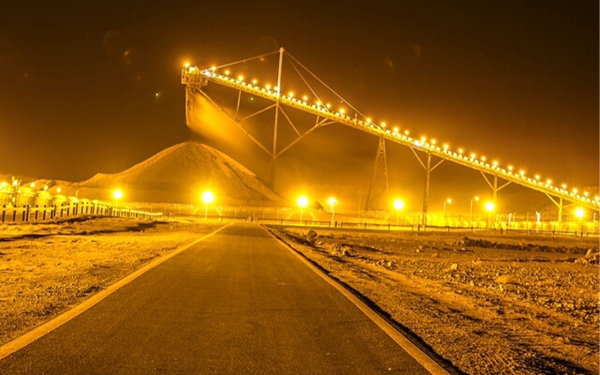
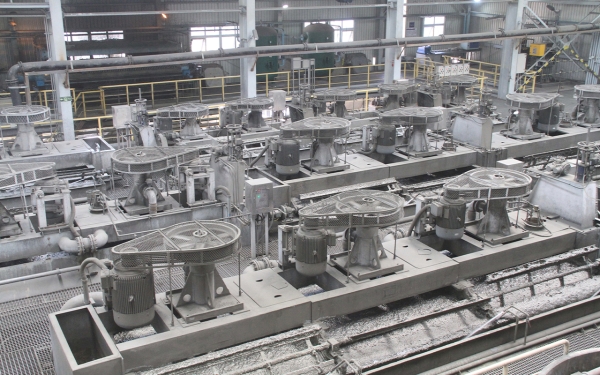
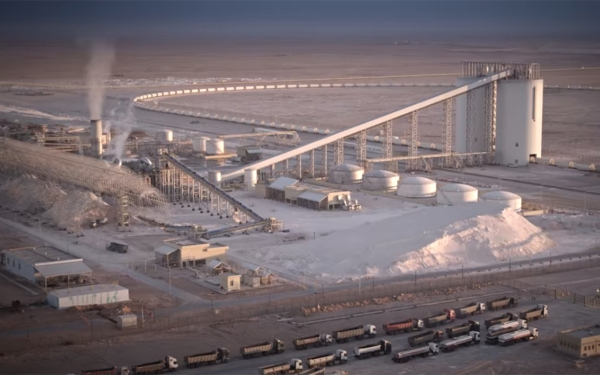
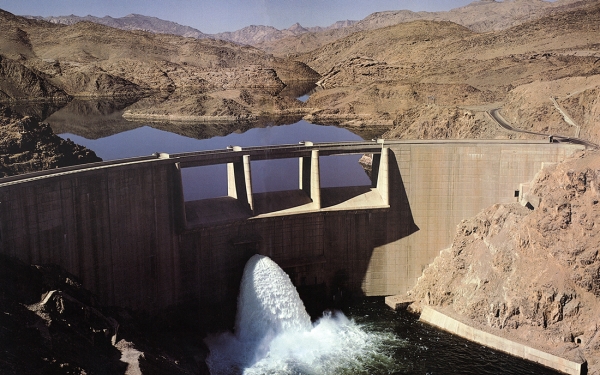
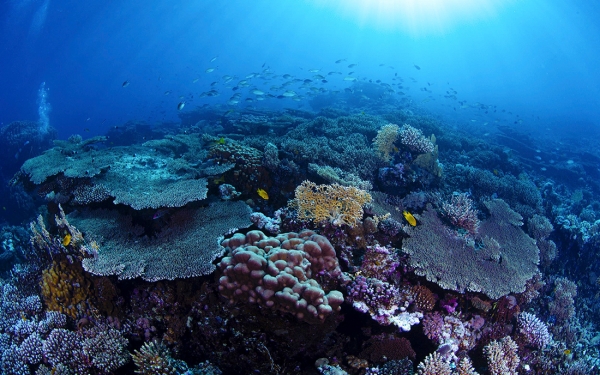
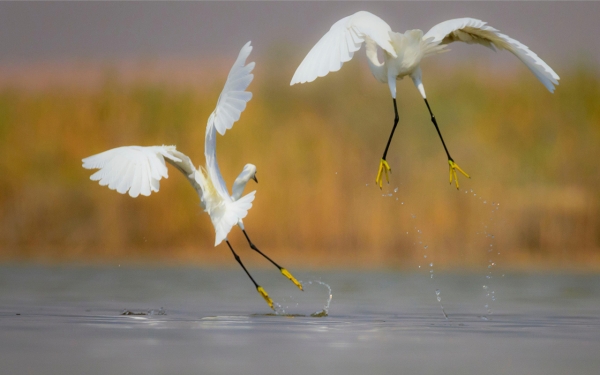
Natural Resources in the Kingdom of Saudi Arabia consist of a huge variety of raw materials, including mineral resources, crude oil, gas and water resources. These materials offer an economic incentive for the Kingdom. The Kingdom's geological diversity contributes to its abundance of resources, ranking it second among the top ten countries for natural resource reserves, with a value of USD34.4 trillion. The Kingdom encompasses the world's second-largest oil reserves after Venezuela. It is also the world's sixth-largest gas market.
Introducing Saudi natural sources
An ecosystem's natural resources are defined as all living and non-living materials and their products found in nature that are directly exploited or invested by humans, such as air, water, land, soil, biodiversity, and geological formations of environmental value.
Natural resources in the Kingdom are counted by the Saudi Geological Survey which provides easy-to-use geological data. This will allow various groups of society to benefit from useful information and will assist decision-makers in making vital decisions. Similar bodies were established in various countries to provide communities with knowledge and information, as well as geological maps which were later used to identify the natural resources stored underground and determine their quantities.
Due to its vast geographical area with multiple terrains, the Kingdom stores many natural resources on the surface and underground. According to the Kingdom's Maritime Zones Law issued in 2011, the Kingdom exercises exclusive sovereign rights over its continental shelf for the purposes of exploring and exploiting its natural resources. Natural resources include mineral resources and other non-living resources on the seabed and underground, in addition to sedentary species. The latter are organisms which, at the harvestable stage, either are immobile on or under the seabed or are unable to move except in constant physical contact with the seabed or the subsoil.
All natural resources in the Kingdom are subject to state regulations regarding their preservation and uses. According to the Environmental Law issued in 2020, it is prohibited to exploit, transport, store, sell, or promote any natural resources and their products located within the Kingdom’s territory, including lands, such as islands, airspace, internal waters, territorial sea, its bottom, subsoil, and the airspace. The law also covers all other maritime areas over which the Kingdom exercises sovereignty or jurisdiction rights without a permit or license, in accordance with international law.
Distribution of Saudi natural resources
Saudi natural resources are distributed according to their geological components. Core and industrial mines and mining areas are concentrated in the western region, specifically in the Arabian-Nubian Shield, the Red Sea plains, and Harrat. Basic and industrial minerals are extracted from these mines, most notably gold, silver, copper, and zinc, in addition to phosphate sites in the north of the Kingdom. In the east, where the continental shelf is located, fields and refineries of onshore and offshore energy resources are prevalent, producing gas, oil, and its petrochemical derivatives.
Every geological region in the Kingdom houses its own types of minerals. The Arabian-Nubian Shield, which covers an area of 575,000 km², is the main region where precious metals are found, such as gold and essential minerals, including copper and some industrial metals. On the other hand, the Arabian Shelf, which constitutes two-thirds of the area of the Arabian Peninsula, is characterized by sedimentary rocks and contains some industrial minerals, such as bauxite and phosphate. The Red Sea, which spans 438,000 km², is one of the least explored areas and involves almost no mineral exploration. However, in general, it contains some chemical industry minerals, such as potassium.
Mineral resources in Saudi Arabia
The Kingdom enjoys a diverse mineral wealth across its various regions. Exploration work and the mining industry began in its lands seven years after its unification by the founding King Abdulaziz Bin Abdulrahman Al Saud through the reopening of Mahd al-Dhahab (Cradle of Gold) mine in 1939 in al-Madinah al-Munawwarah, west of Saudi Arabia. The Kingdom includes several gold mines operated by the Saudi Arabian Mining Company (MAADEN), the largest and most modern mine being al-Duwayhi Mine in Makkah al-Mukarramah Province. This developer, which began its commercial production in 2016, owns an estimated reserve of 1.9 million ounces of gold.
The Kingdom has a mineral wealth of more than USD1.3 trillion, as the number of minerals discovered exceeds forty-eight metals, at least fifteen of which are economically viable to exploit, while the untapped value is estimated at SAR5 trillion. The Kingdom exports USD7 billion worth of minerals and associated activities, and the mining sector provides the Saudi population with about six hundred thousand direct job opportunities.
Mining areas in Saudi Arabia
The Kingdom is home to many mining areas according to the geology of each region, as it is characterized by three geological areas: the Arabian-Nubian Shield, where rocks are more than 1,200 million years old; the Arabian shelf, which is estimated to be less than 540 million years old; and the marine regions (the Red Sea and the Arabian Gulf), which were formed during the previous thirty million years.
Uranium minerals are found across the Kingdom in modern granite rocks and pegmatite rocks. Among the most important areas where uranium and its associated elements are found, such as thorium, niobium, tantalum, tin, yttrium, zirconium, and rare earth elements, are al-Ghariyah, Jabal Sayid, Jabal at Tawlah, Jabal al Hamra, Jabal Nataq, Jabal Aby Hayla, Jabal al-Zahed, and Um Alberk.
A number of industrial minerals are available in many locations across the Kingdom. They can be extracted using surface mining, including phosphate in Al Jalamid (120 km), southeast of the city of Turaif; bauxite in Zubayrah (200 km), southwest of Hail; Magnesite in Al Ghazalah Governorate (160 km), southwest of Hail; and silica sand in Jabal Burm and Jabal al-Daghm (40 km) northeast of Riyadh, in addition to other minerals and industrial deposits.
As a result of the diversity of mining activities in the Kingdom, the number of mining complexes by the end of 2022 reached 377, with a total area of 44,365 km², distributed over thirteen regions. At the top of the list is Makkah al-Mukarramah Province with seventy-six complexes, followed by Riyadh with sixty, al-Madinah al-Munawwarah with fifty-three, Aseer with thirty-four, Eastern Province with twenty-five, Najran with twenty-four, al-Qassim with twenty-three, al-Jouf with twenty, al-Bahah with seventeen, Hail with sixteen, Tabuk with fourteen, Jazan with eleven, and the Northern Borders Province with four.
The Kingdom also encompasses a number of mineralized belts, which amounted to thirty-five sites by the end of 2022. They consist of specific geological regions and formations that contain many mineral deposits, located in an area of more than 305,000 km, equivalent to 14 percent of the Kingdom's total area. Mineral belts are distributed across the Kingdom's provinces with nine belts in Makkah al-Mukarramah, seven in Aseer, six in Riyadh, five in Tabuk, four in al-Madinah al-Munawwarah, two in al-Bahah, one in al-Qassim and one in Najran. Mineral belts are distributed according to their type with sixteen belts for gold, fifteen for sulfides, three for nickel, and one for zinc. The raw mineral resources of these belts are estimated at about 75 percent of the Kingdom's geological reserve, which is estimated at SAR5 trillion.
Phosphate deposits are located in the north of the Kingdom in the industrial city of Waad al-Shamal and Hazem Aljalamid, which contain 7 percent of the world's reserves, as phosphate reserves are estimated at 2.7 billion t. The mine at Hazem Aljalamid produces about 11.6 million t of phosphate ore annually, transported via the railway line to Ras al-Khair in the Eastern Province, where phosphate fertilizer factories and Ras al-Khair export port are located.
Mines in Saudi Arabia
Surveys and exploration activities for metallic mineral ores in the rocks of the Arabian-Nubian Shield have identified a large number of sites, including around 980 sites for gold, 610 for silver, 856 for copper, 477 for zinc, 282 for lead, 76 for nickel, 117 for chrome, and 176 for rare elements.
The Kingdom contains large numbers of mines and mineral deposits with various types of minerals, including:
• Mahd al-Dhahab mine
Located in al-Madinah al-Munawwarah, west of the Kingdom. Its mining operations are carried out through subsurface mining. The mine extracts and processes approximately 185,000 t of ore annually, with a concentration of approximately 10 g/t of gold.
• Sukhaybarat mine
Located in al-Qassim. It contains free gold in diorites, on the edges and internal cracks of arsenopyrite crystals, and on quartz veins and their edges. The production capacity of Sukhaybarat mine is 600,000 t per year.
• Balgha mine
Located within al-Madinah al-Munawwarah, south of Sukhaybarat processing plant, and includes a surface mine. Low-concentration ore is processed in the mine's washing and filtration plant, while high-concentration ore is sent to Sukhaybarat for processing.
• Al-Amar mine
Located to the southwest of the city of Riyadh. It is an underground mine with an annual ore mining rate of 200,000 t for the production of gold in the form of copper and zinc concentrates. Production began at the beginning of 2008.
• Al Hajar mine
Located near al-Aqiq Governorate, south of the Kingdom, and includes a washing and filtration plant. It contains loose, fine-grained gold. Its reserves are estimated at about 5 million t, with 6 g/t of gold.
- Zinc mine in Al-Hanikiyah
Located west of the city of Riyadh, and contains about 5.1 million t of ore, with 11 percent zinc and 0.88 percent copper. About 145,000 t can be mined annually using the subsurface mining method.
• Jabal Sayid
Located north of Mahd al-Dhahab and northeast of Jeddah. It contains the largest base metal deposits associated with volcanoes in the Kingdom, in addition to about 20 million t of ore. One million t of ore can be extracted per year using the subsurface mine method.
Al-Duwayhi mine is one of the important mines in the Kingdom, located in the central part of the Arabian-Nubian Shield and extends to the southeast of the city of Zalim. It is part of the tectonic terrane of Afif, which contains similar gold minerals to those found in other mines, such as Sukhaybarat and Balgha. The mine's ore reserves were estimated at approximately 13.5 million t, with a concentration of around 4.2 g/t, which means that it could produce a total of approximately 1.9 million oz of gold.
According to archaeological evidence and ruins of the mining village adjacent to the mine, gold extraction operations were conducted on al-Duwayhi site three thousand years ago. Ancient mining activities were re-explored in the 1950s by geologists working at the Zalim mine. Al-Duwayhi site was re-evaluated through extensive drilling in the early 1980s. The results were encouraging, which led to al-Duwayhi being classified as a primary exploration target in the 1990s.
Mineral resources in Saudi Vision 2030
During 1996 and 1997, the Ministry of Petroleum and Mineral Resources (currently the Ministry of Industry and Mineral Resources) developed a strategy to develop the mining sector and search for opportunities. After the launch of Saudi Vision 2030, the mining sector was able to achieve a qualitative leap in its investments. The vision seeks to make mining the third pillar of the national industry. Three strategic initiatives were launched as a start to develop the sector, thus requiring geological surveys, identifying investment opportunities in this sector, in addition to studying possible incentives for its development.
Ambitious goals and a comprehensive strategy for the mining sector have been set for Saudi Vision 2030, in cooperation with the National Transformation Program. The vision aspires to set greater emphasis and expectations for the mining sector, expand the exploration and development of mineral resources, and increase the mining sector's contribution to the GDP in order to reach SAR97 billion, in addition to reviewing the procedures for obtaining licenses. Through the National Transformation Program, priority was given to adopting and implementing the comprehensive strategy for the sector, and setting the development of the mining sector as a priority initiative.
Energy resources in Saudi Arabia
The Kingdom's natural resources include hydrocarbons, all of which are owned by the State. Through the 1933 concession, the government granted Saudi Aramco exclusive rights, including the right to explore, develop, and produce hydrocarbon resources within a limited area of the Kingdom. Starting December 24, 2017, the original concession agreement was superseded and replaced by an amended concession agreement granting the company the exclusive right to drill, excavate, foresee, develop, extract, and produce hydrocarbons in the concession area. The company was also granted the exclusive right to market and distribute hydrocarbons, petroleum products, and liquefied petroleum gas in the Kingdom.
The initial term of the concession agreement was forty years, with a possibility for the government to extend it for a period of twenty years, unless Saudi Aramco does not meet certain conditions commensurate with its current operating practices. Moreover, the concession agreement may be amended and extended for an additional forty years beyond the prior sixty-year term subject to Aramco, and if the government agrees to the terms of the extension.
Hydrocarbon resource reserves
The Kingdom's reserves in crude oil and gas fields operated by Saudi Aramco were the same as the company's reserves until December 2017. However, as of this date, the concession agreement stipulated Saudi Aramco's exclusive right to explore, develop, and produce hydrocarbons in the Kingdom, except for resources located in the excluded areas.
According to the concession agreement, Saudi Aramco will manage the Kingdom's resource base and reserves to improve production in accordance with the Hydrocarbons Law. The latter requires the company's activities in the field of hydrocarbon materials to enhance the productivity of the Kingdom's reservoirs in the long term and manage its hydrocarbon resources. As a result, the Kingdom's estimated proven reserves in the largest oil fields managed by Saudi Aramco increased compared to the beginning of production.
Crude oil reserves
Oil flow in commercial quantities in 1938 from Well No. 7 in the city of Dammam, easter of the Kingdom, known as Well of Goodness, and the following increase in wells and production volume, led to an economic leap and enhanced luxury levels in the Kingdom. This boom was accompanied by the foundation of the infrastructure and the first governmental institutions, thus making the oil sector the primary source of the economy, accounting for 27.4 percent of the Kingdom's domestic product.
Saudi Aramco manages all reserves of hydrocarbons. As of December 31, 2022, these reserves across various fields amounted to 338.4 billion barrels of oil equivalent, including 261.6 billion barrels of crude oil and condensates, 36.1 billion barrels of natural gas liquids, 246.7 trillion standard cu ft of natural gas, with 156.9 trillion standard cu ft of non-associated gas.
Based on the initial forty-year concession period and the twenty-year extension, Saudi Aramco's reserves amounted to 258.8 billion barrels of oil equivalent as of December 31, 2022. Saudi Aramco's portfolio includes 535 reservoirs in 142 fields distributed throughout the Kingdom and its territorial waters.
Natural gas reserves
The Kingdom ranks fifth globally in terms of gas reserves, possessing 325.1 trillion cu ft of gas. It is one of seven countries that have the highest demand for natural gas in the world. The Kingdom's gas business began thirty-seven years after the advent of oil when Saudi Aramco operated the Kingdom's first natural gas gathering network in 1975.
Until 2019, the number of reservoirs for extracting and processing associated and non-associated natural gas and unconventional gas was 510 reservoirs and 138 fields, most of which are located in the eastern and northern of the Kingdom. The Jafurah non-associated gas field is the largest, with an area of 17,000 km and an estimated reserve of 200 trillion standard feet of raw gas.
Unconventional resources
Unconventional resources are one of the Kingdom's natural energy resources, and they are present in the reserves. Hydrocarbons are trapped in layers of poorly permeable rock, and can only be accessed using special methods, such as horizontal drilling and hydraulic fracturing. Unconventional gas resources are often called low-permeability shale gas, or shale gas.
Saudi Aramco is exploring for oil and gas. It is conducting pilot projects, and building the infrastructure needed to access unconventional reserves in fields such as North Arabia, South Ghawar, and Jafurah. Unconventional gas resources are confined to dense shale formations. The standard method for extracting shale gas involves pumping fluids containing sand, water, and chemicals into wells to break up the rocks and release the trapped gas, and increase its flow.
Unconventional resources are part of Saudi Aramco's scope of work, which is evaluating several areas within the Kingdom to determine if gas and associated liquids are present. Through its unconventional resources program, Saudi Aramco will help meet future domestic energy needs. The program involves exploration activities, pilot projects, and the development of wells and production facilities.
Saudi Aramco's unconventional gas program provides low-cost and low-carbon energy and includes a number of fields, such as:
- Jafurah field
The largest underground unconventional gas field in the Kingdom, with an estimated reserve of about 200 trillion standard cu ft of gas. The field is expected to produce 420 million cubic feet per day of ethane, and about 630 thousand barrels per day of gas liquids and condensates to be used as feedstock for the petrochemical industry.
- North Arabia field
It is Saudi Aramco's first unconventional gas project, as it began operating in 2018. It provides more than 200 million standard cu ft per day of natural gas for low-carbon power generation and industrial projects.
- South Ghawar field
An unconventional gas field located south and west of the giant Ghawar oil field, and leverages the existing infrastructure of the main gas network.
Renewable energy in Saudi Arabia
The Kingdom has the necessary capabilities to produce renewable energy from various sources, with a focus on solar energy, due to its location in the middle of the solar belt. Moreover, it leverages wind energy, as the annual average coastal wind speed is relatively high and much higher than the average for most countries. The Kingdom currently ranks sixth in terms of solar energy potential in the world, and thirteenth in terms of wind energy potential.
With the expansion of renewable energy technologies, the Kingdom has increased its use of this type of energy, and its installed renewable energy capacity reached 142 MW by the end of 2018. Moreover, wind energy has produced 3 megawatts, solar energy 139 MW, of which 89 MW are generated from photovoltaic (PV) cells, and 50 MW from concentrated solar energy.
In line with the goals of Saudi Vision 2030, and within the framework of the National Renewable Energy Program (NREP), the Kingdom launched two renewable energy projects in 2018 in the northern region. The first project consists of a 300 MW solar PV plant, and the other is a 400 MW onshore wind project.
According to the Saudi renewable energy strategy, the solar target for 2023 was raised from 5.9 GW to 20 GW in order to increase renewable energy sources from 9.5 GW to 27.3 GW. Moreover, the Renewable Energy Projects Development Office also set a general target of 40 GW for solar energy and 58.7 GW for renewable energy by 2030.
Solar power plants in Saudi Arabia
The Kingdom's renewable energy ecosystem includes solar energy plants, as it is one of the countries with the highest rates of solar radiation in the world. The Kingdom's renewable energy ecosystem includes solar energy plants, as it is one of the countries with the highest rates of solar radiation in the world.
It also implemented a number of solar energy projects in various regions, including:
The Sudair Solar PV Park
The total capacity of the project is 1,500 MW in Riyadh Province.
It will be one of the largest solar energy plants in the world and the largest of its kind in the Kingdom. It is also the first project to be implemented within the framework of the National Renewable Energy Program (NREP) supported by the Public Investment Fund. The project recorded the second-lowest worldwide production cost for solar energy. The Sudair Solar PV Park will meet the energy needs of 185,000 residential units, and reduce carbon emissions by approximately 2.9 t per year.
The Sakaka IPP photovoltaic (PV) solar project
One of the NREP projects. It is located 30 km from the city of Sakaka in al-Jouf Province, in the north of the Kingdom. It spans 6 km² and became operational in 2020.
The project is affiliated with the Ministry of Energy, and is the first project of the Custodian of the Two Holy Mosques Renewable Energy Program. The plant consists of 1.2 million solar panels. The plant's production capacity reaches 300 MW, and it reduces carbon emissions by about 606,000 t annually.
Al Shuaibah PV Park
The total capacity of the project reaches 600 MW and it is located 80 km south of Jeddah Governorate. The project set a world record of the lowest cost in purchasing electricity produced from solar energy in the world.
Rabigh Solar PV Park
The total capacity of the project is 300 MW, and it is located 25 km from Rabigh Governorate.
Jeddah Solar PV Park
The total capacity of the project is 300 MW, and it is located in the third industrial city of Jeddah, 50 km from Makkah al-Mukarramah.
Qurayyat Solar PV Park
The total capacity of the project is 200 MW, and it is located 10 km from Qurayat Governorate, north of al-Jouf Province.
Al-Madinah Solar PV Park
One of the projects that stimulate Saudi companies to contribute to the renewable energy sector, and gain experience in developing renewable energy projects. The project is located 26 km from al-Madinah al-Munawwarah, with a total capacity of 50 MW.
Rafha Solar PV Park
The project is located in the Northern Borders Province, 16 km from Rafha Governorate, with a total capacity of 20 MW.
Wind power plants in Saudi Arabia
Wind energy is produced by using wind turbines to produce electrical energy. This type of energy is abundant, less expensive, and renewable. It is clean, and does not produce any harmful gases, such as carbon dioxide or methane.
Wind energy monitoring devices have been used on an experimental level in the Kingdom. The Dumat al-Jandal project, which is located in al-Jouf Province, is the most prominent project that uses this type of energy. The project set a world record at the financial closing stage, as the lowest cost for purchasing electricity in the world produced from wind energy. Its production capacity is 400 MW.
National Renewable Energy Program (NREP)
The National Renewable Energy Program is one of the strategic initiatives under the umbrella of Saudi Vision 2030 and the King Salman Renewable Energy Initiative. It aims to maximize the Kingdom's share in renewable energy production. By diversifying the Kingdom's energy mix, NREP will not only reduce the nation's dependence on oil and its greenhouse gas emissions as part of the Paris Agreement, but will also enable job creation, stimulate economic development throughout the Kingdom, and support long-term prosperity, in line with Saudi Vision 2030 goals.
NREP creates a new industry for renewable energy technology, and supports the development of this promising sector by harnessing private sector investments, and encouraging public-private partnerships. The Renewable Energy Projects Development Office was established under the umbrella of the Ministry of Energy, Industry, and Mineral Resources (currently the Ministry of Energy) in 2017 to achieve the goals of the National Renewable Energy Program, in line with Saudi Vision 2030.
According to the office’s work strategy, it forms a unified leadership through the Kingdom’s capabilities in energy research, measurement, data collection, organization, and development. The office also releases renewable energy tenders, in cooperation with stakeholders in the Saudi energy sector, including King Abdullah City for Atomic and Renewable Energy, Electricity and Cogeneration Regulatory Authority, and Saudi Electricity Company.
The launch of this program is part of the Kingdom’s comprehensive national development strategy framework to support the diversification of energy sources and to achieve its goal of reaching 9.5 GW by 2030, and 54 GW by 2040. The Kingdom reviews the legal and regulatory framework for private sector investment in renewable energy sources. It also localizes the industry by encouraging public-private partnerships and ensures the competitiveness of renewable energy by gradually liberalizing the fuel market.
The Kingdom exerted great efforts to develop the renewable energy ecosystem. These efforts include:
- Joining the International Solar Alliance.
- Signing an agreement with SoftBank to establish a 200 GW solar project at USD200 billion.
- Announcing the Kingdom's 2030 plan to develop a sustainable solar energy sector.
- Establishing the Renewable Energy Projects Development Office at the Ministry of Energy.
- Attracting foreign capital to contribute to building this sector.
- Connecting medium and small solar energy projects to the Saudi Electricity Grid.
- Finding training institutes to train Saudi youth.
- Providing jobs for citizens in the field of renewable energy.
- Creating a local renewable energy industry.
- Supporting local renewable energy research centers.
The Kingdom’s work to find innovative solutions via the National Renewable Energy Program projects aims to increase its share in renewable energy production and diversify local energy sources. The number of projects in the program reached thirteen, with a total energy capacity of 4,870 MW. Solar energy accounted for 91.8 percent, with a total capacity of 4,470 MW, while wind energy accounted for 8.2 percent, with a total capacity of 400 MW.
NREP seeks to achieve a number of goals by 2024. The Kingdom plans to generate electricity from the program’s projects amounting to 15,108,701 MWh, which will supply 692,557 homes with power. The program’s projects also aim to provide 7,870 job opportunities by the end of 2024 and reduce fossil fuel consumption. This will decrease carbon dioxide emissions by 9,828,156 t/year by 2024.
Water resources in Saudi Arabia
Despite the limited water resources in the Kingdom, it was able to confront the challenges of water shortage through a number of solutions. These resources include renewable and non-renewable surface water and groundwater, and include well water, springs, dams, and rainwater.
Rainwater is the main source of all water resources in the Kingdom. Since they are few, they are considered scarce. Moreover, this water is not fully utilized since it is wasted due to intense evaporation, and the remaining water flows into the valleys for a specific period. Leaking water may be preserved within rock layers with suitable storage capacity. They are called reservoir layers, and this water is referred to as groundwater.
The Kingdom does not have sufficient water sources, and they are limited to specific types, including:
Surface water: The water of the main valleys, the valleys with external drainage, and internal valleys.
Groundwater: Subsurface groundwater, and deep groundwater (geological layers carrying deep groundwater).
Springs.
Wells (private and public).
Desalinated fresh water (salt water desalination plants).
Treated wastewater.
The Kingdom's ability to overlook the Red Sea coast to the west, and the Arabian Gulf coast to the east, allowed it to rely on seawater as a resource. This water is desalinated through thirty separate desalination plants. The Arabian-Nubian Shield in the east of the Kingdom contains non-renewable groundwater, and the Arabian Shield in the west of the Kingdom contains renewable groundwater sources estimated at about 2.8 billion m annually. The Kingdom exploits surface water resulting from torrents and rains through more than 570 dams. Over forty of these dams are large in size, some of which have permanent water reserves. These dams collect approximately 2.6 billion m of water. They support drinking water sources, provide protection from floods, and protect cities and population centers. They also recharge the groundwater for irrigation purposes.
Groundwater
Groundwater is extracted from wells. It contains a low concentration of salinity, making it suitable for use or drinking. This water is also stored below the surface of the earth in porous areas of the soil, or in the cracks of geological formations.
Groundwater in the Kingdom is linked to its geological history, as large groundwater resources were formed hundreds of thousands of years ago. A thick series of sedimentary aquifers that cover the entire eastern part of the Kingdom (the Arab continental shelf) store abundant non-renewable fossil groundwater resources. The portion of water resources that is accessible through current or modern extraction technologies, and that is not brackish or saline, is known as exploitable groundwater resources.
Estimates indicate that the total quantities of groundwater stored in all aquifers are about 2,360 billion m, and some of this water is restocked and is estimated at about 3 billion m annually. In the Kingdom, eight main aquifer groups carry groundwater, while five secondary aquifers also carry groundwater, and have gained some local importance. Groundwater aquifers are very dense. Some of them extend from the northern border in the south to the Empty Quarter desert, and in the east from the center of the Arabian Peninsula to the Arabian Gulf. In the Eastern Province, a number of groundwater aquifers are stacked on top of each other and are often separated by less permeable geological formations.
Most of the groundwater resources in the Kingdom are concentrated in the water-bearing layers of the Arabian Shelf, and are classified as renewable groundwater and non-renewable groundwater. The main reason behind the rise of the main and secondary water-bearing formations is not rainfall at its current low rates, which average 150 mm annually, but rainy periods with abundant rainfall that the Kingdom has witnessed, and were known as the rainy ages. At the time, that rain was estimated to be five times today's levels. Consequently, huge quantities of groundwater were stored in the layers of sedimentary rocks of the Arabian Shelf, which covers 1,600,000 km², equivalent to 70 percent of the Kingdom's total area.
The movements that the Kingdom was exposed to in the late tertiary geological period during the Miocene and Pliocene epochs have increased the efficiency of groundwater storage at different levels across the Arabian shelf. As a result, some sedimentary layers were twisted, thus forming a number of folds, either concave or convex. Moreover, some faults and grooves were cracked along the sedimentary layers of the Arabian shelf, which allowed the water to access and settle in underground layers.
The main water-bearing formations in the Kingdom include nine formations: Saq, Tabuk,Wajid , al-Manjoor, Darma, al-Wasi'ah, Al-Bayyad, Umm Radmah, Dammam, and the Neogene. The first six formations, namely Saq, Tabuk, Wajid, al-Manjoor, Darma, al-Wasi'ah, and al-Bayyad, date back to the Paleozoic (ancient life) and Mesozoic (middle life) eras. They are made of sandstone and are characterized by their wide expansion, great thickness, and large amounts of water. Their waters are generally of good quality and are mostly confined within sedimentary layers, which means water rushes to the surface when drilling wells in these formations. As for the other three formations, Umm Radmah, Dammam, and the Neogene, they consist of carbonate rocks dating back to the Cenozoic era.
The secondary water-bearing formations in the Kingdom also constitute an important source of water on a local scale, despite their poor water quality, low productivity, and weak potential for development and growth. These nine formations are: Al-Jouf, Abu Rawath, al-Khif, al-Jallah, Darma, the Upper Jurassic, the Lower Jurassic, Sakaka, and al-Arma.
Activities to access deep groundwater have developed in the Kingdom. The first tube well to drill groundwater in 1936 was managed by oil exploration companies near the city of Dhahran. These efforts were followed by successive discoveries of large quantities of groundwater by oil companies that were granted exploration concessions in the Kingdom. Most of the drilled formations contained confined water from which the water flowed directly.
Surface water
The Kingdom contains many sources of surface water. They provide fresh water, which includes all forms of fresh water on the Earth's surface, such as water from rivers, streams, lakes, wetlands, swamps, valleys, and dams. The marine coastal waters are located within the scope of the Kingdom (territorial waters which are defined as all coastal marine areas, the contiguous zone, and the exclusive economic zone). All of these waters are classified freely, unless they are industrial or of high value, and are declared as protected areas locally or internationally by any competent entity.
The Kingdom owns maritime zones that represent the maritime scope determined by its sovereignty over the following three bodies of water: The Arabian Gulf, the Red Sea, and the Gulf of Aqaba. These are areas that are subject to the Law of the Sea and the Kingdom’s internal regulations. The Kingdom's maritime areas span about 230,900 km², including around 195,400 km² in the Gulf of Aqaba and the Red Sea, and about 35,500 km² in the Arabian Gulf.
The total inland water area is estimated at about 79,200 km², including 66,200 km² on the Red Sea and the Gulf of Aqaba, and 13,000 km² on the Arabian Gulf, followed by the territorial sea. Its total area is estimated at about 47,700 km², including 36,200 km² in the Gulf of Aqaba and the Red Sea, and 11,500 km² in the Arabian Gulf. Then, the exclusive economic zone is estimated at about 104,000 km², including 93,000 km² in the Gulf of Aqaba and the Red Sea, and 11,000 km² in the Arabian Gulf.
In order to collect rainwater, many water traps have been deployed in low-lying areas. They were formed as a result of various factors, including the receding sea water from some lands near the shores, where these traps are formed and are abundant within and near coastal areas, or they are the remains of ancient lakes. Some of these traps were formed as a result of natural features, such as rocky ledges, sand dunes, and volcanic calves, intercepting with rainwater streams.
There are many types and names for these traps. They vary according to their composition, the type of soil, and the extent of their permeability. Some of them have porous, sprouted, and arable soil, such as al-Khabari, al-Rawdat, and al-Fayyad. Some of these traps have non-porous, non-sprouted soil, such as al-Qi’an. Others have saline soils, such as sabkha and al-Mamaleh.
Water traps in the Kingdom are more concentrated in the Arabian Shelf (sedimentary cover) than in the Arabian-Nubian Shield. Water traps are divided according to their composition and type of soil including al-Khabari, al-Rawdat, al-Fayyad, al-Qi’an, sabkha, and al-Mamaleh. Moreover, the southwest of the Kingdom includes six main basins: Wadi Najran, Wadi Habouna, Wadi Tathleethh, Wadi Bishah, Wadi Ranyah, and Wadi Taraba.
Valleys are among the most prominent natural phenomena in the Kingdom, with hundreds of seasonal watercourses spreading over their surface, most of which occur during rainy periods. They are distributed throughout all its regions, but are less frequent in the southern part of the eastern region, and are absent in the Empty Quarter. The main streams in the Kingdom are called valleys and reefs. Tributary names vary from one region to another and include: Ba'ija, Bahra, Khir, Khanqa, Khoor, Dahla, Di'ab, Duaykhla, Rijla, Sahiba, Sayila, Sir, Silil, Sahib, Shijna, Shitna, Shighya, Aa'ira, Aa'ila, Ghawya, Ghir, Faj, Nassifa, Nazim, and Hithlool.
Wadi al-Rummah – Al-Batin is one of the most important valleys of the Arabian Peninsula. It begins from the eastern slopes of the city's mountains, heading towards the east. It receives more than three hundred tributaries, including small ones called tila'a. The valley's length is as follows:
Main stream: 600 km long
Wadi al-Ajardi stream: 40 km long.
The length of the stream hidden by the sands of al-Thuwayrat and Dahana: 160 km.
The length of Al Batin stream from al-Batin to al-Zubair: 425 km.
Wadi Hanifah – Al-Sahba' is one of the famous valleys in the Kingdom. It is about 200 km long, and streams from the northwest to the southeast. Riyadh City is located on Wadi al-Bathaa before it converges with Wadi Hanifah, near the middle of its course. Villages and towns are located along its course, and this valley ends at the lowest point of Al-Kharj (Al-Sih region).
Wadi al-Dawasir and its ancient tributaries are also some of the most important valleys of the Arabian Peninsula. It heads towards the east, crossing the Tuwaiq Plateau, ending at the starting point of the Empty Quarter. Its length does not reach 300 km. The tributaries of this valley include Wadi Tathleeth, Wadi Bisha, Wadi Ranyah and Wadi Taraba.
Wadi Sirhan is located in the far northern corner of the Kingdom, to which tributaries converge from all sides, the most important of which is the western side, which drains the waters of the Jordanian plateau. Some of them begin from Mafraq and some from Ma'an. Its length reaches about 480 km. Its width varies from one place to another and sometimes reaches 16 km. This valley appears to encompass a number of sabkhas.
Desalinated water
The Kingdom has overcome the challenges of water shortage through desalination works by obtaining desalinated water after removing salt from the sea or salty groundwater.
The Kingdom is the largest producer of desalinated water in the world, as it owns 22 percent of the total global production of desalinated water. Its strategic location overlooking the Arabian Gulf to the east and the Red Sea to the west, and its relatively low levels of rainfall, in addition to its dry continental climate overall, explain its dependence on water desalination to meet 60 percent of its annual needs. Moreover, it collects the remaining 39.5 percent from groundwater wells and dams.
The Kingdom’s water desalination production reached more than 2 million m, according to 2022 data, through thirty separate stations between the western and eastern coasts. The water is then transported through pipelines with a total length of 10,155 km.
The Kingdom has a long history with water desalination, which began more than one hundred years ago with the use of a condensing unit for seawater distillation in 1907, known as al-Kandasa. It was the first desalination unit on dry land to support freshwater sources in Jeddah Governorate. However, this attempt was unsuccessful. Founding King Abdulaziz Bin Abdulrahman Al Saud ordered the importation of two sizeable machines that used the same technique to distill seawater in 1927 in order to sustain freshwater sources in Jeddah Governorate for Hajj and Umrah pilgrims.
With the increase in water consumption in the Kingdom, desalinated water has become its primary water resource, in addition to non-renewable groundwater, renewable groundwater, surface water, and treated water. The Kingdom has established desalination plants located on the eastern and western coasts to meet the demand for water. The total production capacity of water desalination reached 6.28 million m per day in 2015, and increased to 6.6 million m in 2022.
National Water Strategy
The Kingdom has developed a national water strategy to achieve a number of goals related to providing water for various purposes. It is requiring a constant annual increase of 7 percent, and its agricultural sector is the largest consumer of water in the Kingdom, with 84 percent of the total demand for water. Water use in the agricultural sector reflects an environmental challenge, given its reliance on non-renewable resources, which represent 90 percent of the total water supplied to the sector.
Therefore, the Kingdom seeks to reduce water losses (estimated at over 25 percent in different regions and buildings). The main focus is shifted towards water desalination (60 percent of the total water supply in the civil sector). Therefore, the Saudi National Water Strategy 2030 aims to address all major challenges, benefit from previous and ongoing studies, and reform the water and sanitation sector to ensure sustainable development of water resources in the Kingdom, while providing high-quality services at reasonable prices.
The National Water Strategy involves a vision, strategic objectives, and associated programs and initiatives. Its vision relies on a sustainable water sector that develops and preserves water resources, maintains the environment, and provides a safe supply and high-quality and efficient services, which contribute to economic and social development. It seeks to achieve five strategic goals:
Ensuring continuous access to sufficient quantities of safe water in normal and emergency situations.
Improving water demand management for all its uses.
Providing high-quality, cost-effective water and sanitation services to ensure affordable prices.
Preserving water resources, and improving their use while maintaining the local environment in a way that benefits Saudi society in the present and the future.
Ensuring the competitiveness of the water sector and its positive contribution to the national economy by enhancing effective governance, private sector participation, and localizing capabilities and innovation.
National Water Strategy programs and initiatives
The National Water Strategy implements programs and initiatives derived from the sector's five strategic objectives. Through an in-depth analysis of the various elements and components, ten main programs were developed, each including a set of strategic initiatives:
Program 1: Water law and regulations for water resources management. It aims to provide a comprehensive series of policies and implement a suitable legal and legislative framework for water resources management. The Ministry of Environment, Water and Agriculture is implementing this program.
Program 2: Water resources management. The program was designed in a way to implement integrated resource management and planning in the Kingdom. It also aims to ensure the best use of available water resources by rationalizing current resources, such as renewable groundwater, surface water, and treated wastewater. The program also reduces current consumption rates in municipal and agricultural sectors. This program includes fifteen initiatives, and is supervised by the ministry.
Program 3: Sector readiness to manage emergencies. The program aims to ensure the continued readiness of the water and sanitation sectors to face any disruption to normal daily operations. This program ensures that the Ministry of Environment, Water, Agriculture and related facilities take into account all potential risks that could disrupt operations at every step of the water supply chain. This program is being implemented under the auspices of the ministry and the Water Affairs Agency, and includes three initiatives.
Program 4: Research, development, and capacity building. This program advances research, development, and localization, and improves leadership and water management capabilities. This program will be implemented under the auspices of the Water Affairs Agency in the Ministry of Environment, Water, and Agriculture, and includes three initiatives.
Program 5: Supply chain efficiency and service quality. The water supply chain in the Kingdom still faces several operational and service quality challenges. The strategy proposes a program to improve sector operations and service delivery. This program will be completed under the auspices of the Distribution Affairs of the Ministry of Environment, Water, and Agriculture, and includes seven initiatives.
Program 6: Water service regulations: It is designed to ensure that the regulator, which is the Electricity and Cogeneration Regulatory Authority (ECRA), fulfills its role in regulating water services alongside electricity and cogeneration. It is strongly linked to the policies, laws, and regulation programs. The ECRA will sponsor this program This program is implemented under the auspices of the ECRA and includes four initiatives.
Program 7: Reconstruction of the Saline Water Conversion Corporation (SWCC): This program is developed as part of the SWCC allocation strategy. It is responsible for restructuring and transforming SWCC to achieve the objective that was assigned to it. This program is implemented under the auspices of the SWCC and includes three initiatives.
Program 8: Engaging the private sector in the production and treatment of wastewater. This program was prepared within the framework of the Saline Water Conversion Corporation’s privatization strategy project. It focuses on assembling production and wastewater treatment assets for privatization purposes. It is being implemented under the auspices of the Water and Electricity Company and includes three initiatives.
Program 9: Restructuring distribution and engaging the private sector. The program aims to transform the structure of the distribution sector by harmonizing distribution facilities, and ensuring their readiness for the privatization process. This program is being implemented under the auspices of the National Water Company and includes four initiatives.
Program 10: Restructuring the General Irrigation Corporation and improving irrigation. This program allows for the restructuring of the Saudi Irrigation Authority, previously known as al-Ahsa Irrigation and Drainage Authority, to expand its role. This program is being implemented under the auspices of the Saudi Irrigation Authority and includes three initiatives.
Biodiversity in Saudi Arabia
The Kingdom has a rich biodiversity due to its vast area and different environments. This biodiversity includes a number of living organisms, such as:
Bird diversity
The territory of the Kingdom is one of the most important migration routes for birds from north to south and from east to west, due to its strategic geographical location between three continents. Bird groups found in the Kingdom belong to three origins: Ethiopian (forty-five species), ancient Arctic (357 species), and Asian (thirty species), bringing the total number of bird species recorded in the nation to 499.
Diversity of wild mammals
The Kingdom is home to eighty-six species of mammals, twenty-eight species of bats, twenty-two species of rodents, twelve species of carnivores, and one species of primates (baboons), in addition to four species of antelopes, including the Arabian oryx. Large mammals are important elements in ecosystems, as their condition reflects the health of the environment in which they are found. In recent years, large mammals in the Kingdom have been subjected to great pressure. Some of them have disappeared, and others have become threatened with extinction, such as the Arabian leopard, whose numbers are estimated at no more than 150. Large groups of Arabian Oryx roamed throughout the Arabian Peninsula. However, their numbers began to decline due to poaching activities during the nineteenth century.
Diversity of marine mammals
Sixteen species of marine mammals have been recorded in Saudi territorial waters in the Red Sea and the Arabian Gulf. One species of the sirenias exists in large numbers, which is the sea cow (dugong). It is concentrated in some locations of the Arabian Gulf and the Red Sea. As for the cetaceans, which include whales and dolphins, six types of whales are present in the Kingdom: the sperm whale, the killer whale, the minke whale, the Bryde’s whale, the fin whale, and the humpback whale. Nine species of dolphins are registered in Saudi territorial waters: Bottlenose dolphin, rough-toothed dolphin, humpback dolphin, common dolphin, striped dolphin, spinner dolphin, pantropical spotted dolphin, Risso's dolphin, and Indo-Pacific bottlenose dolphin.
Diversity in reptiles and amphibians
107 species of reptiles and seven species of amphibians have been recorded in the Kingdom. Reptiles include forty-four species of lizards and seven species of turtles. Five species of sea turtles have been recorded in the territorial marine waters of the Kingdom. Seven species of amphibians live in the Kingdom, and they belong to the batrachias, all of which need to be maintained.
Diversity in marine fish
About 1,280 species of fish swim in the waters of the Red Sea, and about 542 species in the Arabian Gulf. Forty-four species of sharks have been recorded in the Red Sea and the Arabian Gulf. The number of commercial fish species reaches 180 in the Red Sea, compared to 110 species in the Arabian Gulf. The inland freshwater environment contains seven species of fish, including five endemic species.
Diversity of marine invertebrates
Marine invertebrates are the largest fungal fauna in terms of diversity and abundance in the Kingdom. They still require major intensive studies, as the information available about them is limited.
Wildlife
The geographic location of the Kingdom, in addition to being situated within two desert regions (the Eurasian region and the tropical African region), diverse climate and biological composition. This, in turn, has fostered a wide range of ecosystems and biodiversity within the Kingdom.
With the aim of preserving biodiversity in the Kingdom, a document, entitled A national system for conserving wildlife and sustainable rural development in the Kingdom of Saudi Arabia, has been prepared in 1991. The declared network of protected areas was established until this day based on said document in the Kingdom. In accordance with environmental developments, the updated ecosystem includes a proposal to protect seventy-five areas (including sixty-two terrestrial areas and thirteen coastal and marine areas).
The Kingdom has issued a number of laws and legislation to protect wildlife, thus regulating the hunting of wild animals and birds, and the trade in endangered wildlife and their products, including:
- General Environmental Law and its implementing regulations.
- The Law of Protected Areas for Wildlife.
- Hunting of Animals and Birds Law.
- Law of Trading in Endangered Species of Wildlife and its Products.
- United Nations Convention on Biological Diversity.
- Marine ecosystem and fisheries studies.
The Kingdom seeks to preserve all wildlife, including underwater life. The National Strategy for Preserving the Kingdom's Biodiversity was adopted in 2005, aiming to ensure the preservation and development of biodiversity.
The Kingdom's efforts to preserve its natural resources extend to living organisms and their environments, as they contain a number of special habitats and natural reserves. The National Center for Wildlife Development supervises a group of fifteen reserves across various regions of the Kingdom.
Mountain ecosystems
With the expansion of the Kingdom’s geography, its ecosystems are numerous, and embrace various natural resources, depending on the diversity of the country’s topography and geology. Its ecosystems include mountain systems, in which tree forests are abundant, especially juniper forests that spread in the Sarawat Mountains in the southwestern region of the Kingdom. Other species also grow in these mountains, such as some acacia trees, wild olive trees, etc. These environments contain the highest rates of biodiversity in Saudi terrestrial environments. They also produce some products, such as some medicinal and aromatic herbs and apiaries.
These ecosystems are ideal environments for many species of wild animals, the most important of which are the Nubian ibex and the mountain gazelle. The Kingdom preserves these environments by rehabilitating degraded forest sites, especially in the southwestern region of the Sarawat Mountains, where the juniper ecosystem has been restored.
Natural pastures
Desert areas cover large parts of the Kingdom. However, a number of zones contain natural pastures on an area of 171 million ha, distributed across the Kingdom in different proportions, most of which are located in areas that receive a rainfall rate of less than 200 mm/year. The largest part of the Saudi pasture area is located in the northern, eastern, central, and southern regions. Large pasture areas are found in various sandy zones, gravel plains, and rocky plateaus. More than two-thirds of this area is located in places that receive a rainfall rate of less than 100 mm/year.
As a result of these rainfall rates, most of the Kingdom’s pastures consist of scattered desert grasses and shrubs of low density, and their coverage of the Earth’s surface is low. These pastures are characterized by their low pastoral production capacity, and the fluctuation of production from year to year and from one region to another, according to the variation in the amount of rain and the regularity of the rain's distribution, as most of the pastoral production occurs during rainy seasons.
Large areas of pastures contain a number of Saudi lands with a low density of plants and low coverage. Nonetheless, Saudi pastures are characterized by their diversity in more than one aspect. Pastures in the Kingdom have been classified into two main types: pastures whose condition ranges from excellent (8 percent) to good (31 percent) and pastures whose condition ranges from poor to deteriorated (61 percent). Natural pastures in the Kingdom are characterized by their annual plants spread in large parts, and thus the production of these pastures is seasonal.
The percentage of excellent and good pastures in the Kingdom is decreasing, and this is due to two main factors. First, the impact of climatic conditions in the country, as rainfall is limited because the Kingdom is located in a dry tropical region. Second, the number of rainy days is also limited, ranging between fifteen and twenty-five days. The Kingdom's rain is irregular and generates fluctuating quantities. On the other hand, human factors are at play, the most prominent of which is overgrazing, especially in the northern and eastern regions.
Pastures in the Kingdom have many geographical divisions, according to the diversity of their terrain, including:
Mountain pastures: Mountain pastures are found in the Sarawat Mountains in Aseer, forming what could be called the southwestern pastoral region. This region has the best grazing areas in the Kingdom and is characterized by high average rainfall (200 mm - 500 mm).
Desert pastures: They are found in areas where the annual rainfall does not exceed 150 mm. These areas include the desert areas in Najd and the northern region, as well as the Saudi borders with Iraq and Syria. Moreover, these pastures include the plains of the valleys of the western region, except for the southwestern parts, especially in the Tihama plain. Al-Ahsa region is also part of these pastures.
Mountain ecosystems
The Red Sea is home to some of the world's greatest marine biodiversity. The Arabian Gulf is similar to the Red Sea in terms of its narrow flow, and it is connected to the Indian Ocean through the Strait of Hormuz. The biodiversity in the Arabian Gulf contains plant and animal species that are characterized by their high degree of adaptation to extreme environmental conditions. It is also distinguished by the fact that it includes a great diversity of coastal and marine ecosystems.
Coral reef ecosystems
Coral reefs are widely spread along the Kingdom's coast on the Red Sea. They are found in the form of coral reefs located offshore and in the form of coral fragments in shallow areas. They are also surrounded by scattered islands in the form of coral reefs. The Red Sea encompasses about 270 species of hard coral and forty species of soft coral.
In the Arabian Gulf, coral reefs spread to a limited extent due to the lack of hard layers and unsuitable environmental conditions. The Saudi coast includes sixty types of hard coral reefs. The latter are spread around the islands far from the coast and in a few areas close to the coast.
In marine ecosystems, seagrass beds also lay in shallow waters far from the waves. These mulches provide protection and food for many types of marine life, such as mollusks, crustaceans, fish, turtles, and mermaids. Twelve species of seaweed have been discovered in the Red Sea, including ten species in Saudi waters. Four species of seaweed have also been recorded in the Arabian Gulf, all of them in Saudi waters.
As for coral reefs, their formation was the result of the emergence of most of the Red Sea islands from the remains of coral animals. This confirms that most of the Red Sea's islands are located on coral reefs, and are surrounded by reefs, barriers, and coral rings. This type of coral reef is widely spread in the Red Sea. It is submerged in tidal waters, and some of its heads appear during low tide. It grows in number under the sea towards the south. The Red Sea reefs are distinguished by their diverse shapes, patterns and colors.
The Red Sea is the richest in coral reefs. They are more numerous the farther they are from cities and coastal communities, and the mouths of valleys. About two hundred species of coral are spread in the Red Sea, the most prominent of which is the fringing reef specifically located near the two coasts, thus providing the appropriate environment for its growth and reproduction. Moreover, the absence of rivers and lack of rain, in addition to low tides and moderate water temperatures, help with its growth.
In the waters of the Red Sea, coral reefs are spread densely near the entrance to the Gulf of Aqaba, between the islands of Tiran and Sanafir and the coast, and along the Saudi coast north of the Red Sea. Coral reefs are concentrated near the coast and adjacent to the city of al-Laith, where they begin to spread and expand, reaching their maximum extension in the sea towards the west, about fifty nautical miles between the cities of al-Laith and al-Qunfudhah. Then, these coral reefs set in the coast once more and around the islands until the end of the Saudi coast to the south. The following are some of the most important reefs in Saudi waters in the Red Sea: Aiptasia, al-Bahm, al-Balad, Abu Shosha, al-Dark, al-Jadeer, Mubarak, Abu Sadeen, al-Shuaiba, al-Sabaa, al-Saflani, al-Khmasa, al-Kirsh, Nizar, Abu Madafe'a, al-Kabir, al-Missmari, al-Shajaa, Janabiat, al-Jarm and al-Darah.
In the Arabian Gulf, about sixty types of coral live under the sea, which are less diverse and dense compared to those found in the Red Sea. Coral islands are of great environmental importance, as they are among the most important breeding areas for sea turtles in the Arabian Gulf. They are also attractive for fishermen, as coral reef fish represent about 40 percent of the total fisheries in the Gulf.
Vegetation cover
The Kingdom encompasses a large plant diversity across its various regions, as its environments are suitable for many plant species. Nearly 2,100 plant species have been recorded in the Kingdom, including about thirty-five endemic plant species, i.e., about 2 percent of the total plant species. In terms of spatial distribution, plants are concentrated in the dry areas of the Kingdom, mainly in low-lying areas, such as meadows, valleys, and waterways, where water gathers after rainfall. As for perennial plants, which represent between 35 percent and 40 percent of desert species, they are usually found in limited areas, such as the edges of meadows, valleys, low-lying areas, floodplains, and areas with deep soil. These plants are also found on sand dunes and swamps.
Plant diversity in the Kingdom includes the growth of savanna forests and grasses in the highlands of the south and southwest of the Arabian Peninsula, such as those that spread in northeastern Africa. As for the low desert areas of this region, savannah-like plant species grow, such as acacia, vachellia tortilis, vachellia flava, and other scattered tropical trees.
Plant diversity in the Kingdom also includes the fungal plant group, which includes about 2,247 species belonging to 142 families and 837 genera. Rare or endangered plant species in the Kingdom are estimated at about six hundred, a high percentage that the nation is addressing by taking the necessary measures to preserve these species, especially in light of the rapid rates of economic development, unsustainable land use, and increasing population numbers. Through the establishment of existing and proposed reserves included in the system of protected areas, the Kingdom seeks to maintain a number of its wildlife environments and habitats.
Plant environments
Plant environments in the Kingdom are numerous and vary according to the diversity of the region’s topography. Natural vegetation covers an estimated area of 77 percent of the country, while forests cover no less than 3 million ha. The number of natural plant species in the Kingdom is estimated at about 2,100, including between four and five hundred species of perennial plants.
Saudi plant environments include the following sites and environments:
- Valleys, floodwater streams, and rain drainage channels.
- Aquatic environments: Submerged plants, floating plants, amphibious plants.
- Sand formations.
- Coastal plains.
- Coastal salt sabkhas.
- Internal salt sabkhas.
- Mangroves forests.
- Gravel deserts.
- Al-Hamad Desert.
- Desert plains.
- Desert plateaus.
- Mountainous area.
Plants in the Kingdom are divided according to the type of natural environment into a number of types, including:
- Mountain plants: juniper, vachellia flava, acacia, and sidr.
- Valley plants: acacia, vachellia tortilis, haloxylon, haloxylon persicum, and tamarisk.
- Sand plants: haloxylon, tamarisk, mugworts, and panicgrass.
- Plants of the coastal plains and coasts: acacia and Real Mustard Tree.
- Plants of the internal and northern plateaus: haloxylon persicum, haloxylon, lycium shawii, rumex obtusifolius, and tamarisk.
The vegetation cover in the Kingdom provides suitable environments for a number of migratory birds called summer visitors. The number of migratory bird species in the Kingdom is estimated at approximately more than 260. They are divided into three groups: breeding migratory birds, transient migratory birds, and non-breeding endemic migratory birds.
Among the migratory bird species in the Kingdom, the Philby's Partridge stands out. It lives in the southwestern highlands, in addition to the Arabian partridge in the southwestern highlands, east of the Kingdom, Tihama, and center of the Kingdom. Other birds include the Wheatears in the southern Arabian Peninsula, the Arabian waxbill, and the Arabian serin that lives in the southwestern highlands, Tihama, and the center of the Kingdom, as well as the Arabian Accentor from the southwestern highlands.
Related quizzes

